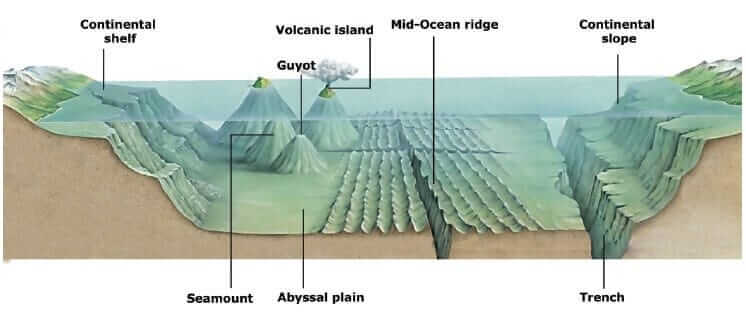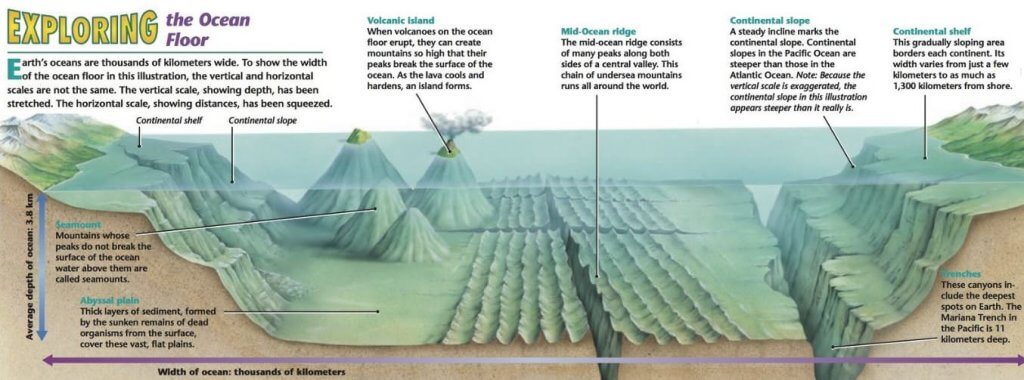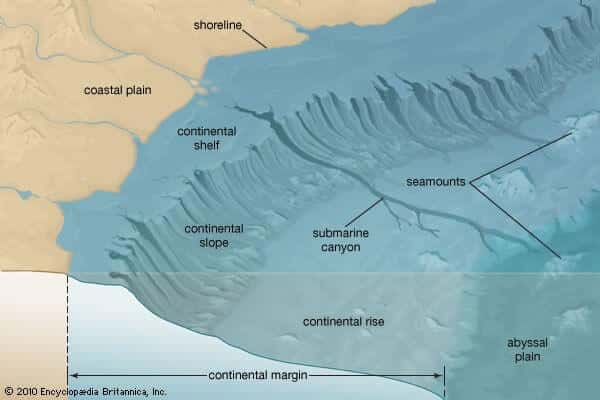Ocean
- The Ocean Relief Features are quite different from the continental features because the Oceanic crust is less than 60-70- million years old whereas continental features are of Proterozoic age (Over 1 Billion years old).
- While there is only one global ocean, the vast body of water that covers 71 percent of the Earth is geographically divided into distinct named regions. The boundaries between these regions have evolved over time for a variety of historical, cultural, geographical, and scientific reasons.
- Historically, there are four named oceans: the Atlantic, Pacific, Indian, and Arctic. However, a new ocean has now been recognized as the Southern (Antarctic) ocean as the fifth ocean. The Pacific, Atlantic, and Indian are known as the three major oceans.
- They are the source of food– fish, mammals, reptiles, salt, and other marine foodstuffs.
- The tides can be harnessed to provide power.
- Oceanography is the branch of science that deals with the physical and biological properties and phenomena of the sea.
- Earlier echo-sounding techniques were used, now radar soundings and electrical Echo devices are used to find the precise depths of ocean floors and map the relief of oceans.
Ocean Relief Features
- The oceans, unlike the continents, merge so naturally into one another that it is hard to demarcate them.
- The geographers have divided the oceanic part of the earth into five oceans, namely the Pacific, the Atlantic, the Indian, Southern, and the Arctic.
- The various seas, bays, gulfs, and other inlets are parts of these four large oceans.
- A major portion of the ocean floor is found between 3-6 km below the sea level.
- The floors of the oceans are rugged with the world’s largest mountain ranges, deepest trenches, and the largest plains. These features are formed, like those of the continents, by the factors of tectonic, volcanic, and depositional processes.

Major Ocean Relief Features
The ocean floors can be divided into four major divisions:
- the Continental Shelf
- the Continental Slope
- the Deep Sea Plain
- the Oceanic Deeps

Continental Shelf
- Continental Shelf is the gently sloping seaward extension of continental plate.
- These extended margins of each continent are occupied by relatively shallow seas and gulfs.
- Continental Shelf of all oceans together cover 7.5% of the total area of the oceans.
- Gradient of continental is of 1° or even less.
- The shelf typically ends at a very steep slope, called the shelf break.
- The continental shelves are covered with variable thicknesses of sediments brought down by rivers, glaciers etc..
- Massive sedimentary deposits received over a long time by the continental shelves, become the source of fossil fuels [Petroleum].
- Examples: Continental Shelf of South-East Asia, Great Banks around Newfoundland, Submerged region between Australia and New Guinea.
- The shelf is formed mainly due to
- submergence of a part of a continent
- relative rise in sea level
- Sedimentary deposits brought down by rivers
- There are various types of shelves based on different sediments of terrestrial origin —
- glaciated shelf (Surrounding Greenland),
- coral reef shelf (Queensland, Australia),
- shelf of a large river (Around Nile Delta),
- shelf with dendritic valleys (At the Mouth of Hudson River)
- shelf along young mountain ranges (Shelves between Hawaiian Islands).
Continental Slope
- A continental slope is the slope between the outer edge of the continental shelf and the deep ocean floor.
- The continental slope is cut by submarine canyons in many locations.
- The continental slope marks the seaward edge of the continental shelf.
- The gradient of the slope region varies between 2-5°.
- It extends between the depth of 180 to 3600 metres.
- In some places, for example, off the shore of Philippines, the continental slope extends to a great depth.
- Continental slopes, mainly due to their steepness and increasing distance from the land have very little deposits of sediments on them.
- Sea life is also far less here than on the shelf.
- Along the base of the continental slope is a deposit of sediments. This belt of sedimentary deposits form the continental rise.
- In some regions the rise is very narrow but in others it may extend up to 600 km in width.
Continental Rise
- The continental slope gradually loses its steepness with depth.
- When the slope reaches a level of between 0.5° and 1°, it is referred to as the continental rise.
- With increasing depth, the rise becomes virtually flat and merges with the abyssal plain.
Deep Sea Plain or Abyssal Plain
- Deep sea planes are gently sloping areas of the ocean basins.
- These are the flattest and smoothest regions of the world because of terrigenous [denoting marine sediment eroded from the land] and shallow water sediments that buries the irregular topography.
- It covers nearly 40% of the ocean floor.
- The depths vary between 3,000 and 6,000 m.
- These plains are covered with fine-grained sediments like clay and silt.
- It has extensive submarine plateaus, ridges, trenches, beams, and oceanic islands that rise above sea level in the midst of oceans.
- E.g. the Azores, Ascension Island

Oceanic Deeps or Trenches
- The trenches are relatively steep-sided, narrow basins (Depressions). These areas are the deepest parts of the oceans.
- They are of tectonic origin and are formed during ocean – ocean convergence and ocean-continent convergence.
- They are some 3-5 km deeper than the surrounding ocean floor.
- The trenches lie along the fringes of the deep-sea plain at the bases of continental slopes and along island arcs.
- The trenches run parallel to the bordering-fold mountains or the island chains.
- The trenches are very common in the Pacific Ocean and form an almost continuous ring along the western and eastern margins of the Pacific.
- The Mariana Trench off the Guam Islands in the Pacific Ocean is the deepest trench with, a depth of more than 11 kilometers.
- Other ocean deeps –
- Mindanao deep (35000 feet)
- Tonga trench (31000 feet)
- Japanese trench (28000 feet) (all 3 in the Pacific Ocean)
- They are associated with active volcanoes and strong earthquakes (Deep Focus Earthquakes like in Japan). This makes them very significant in the study of plate movements.
- As many as 57 deeps have been explored so far; of which 32 are in the Pacific Ocean; 19 in the Atlantic Ocean and 6 in the Indian Ocean.